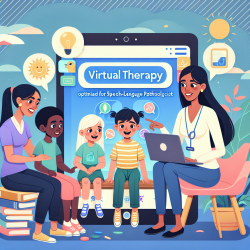Understanding Co-Donation: A New Perspective for Practitioners
In the field of speech-language pathology, practitioners are often guided by data-driven decisions to improve outcomes for children. However, insights from seemingly unrelated research can offer valuable lessons. A study titled Individuals’ Decision to Co-Donate or Donate Alone: An Archival Study of Married Whole Body Donors in Hawaii provides such insights, particularly in understanding the dynamics of decision-making in a collaborative context. Although this study focuses on whole body donations, its findings can be extrapolated to enhance collaborative practices in educational and therapeutic settings.
Key Findings from the Study
The study analyzed records from the University of Hawaii’s whole body donation program, focusing on married individuals' decisions to register as donors either alone or with their spouses. Key findings include:
- 38.2% of married registrants chose to co-donate with their spouse.
- Wives were more likely to co-donate than register alone.
- Occupational background, particularly in female-gendered occupations, significantly influenced the likelihood of co-donation.
These findings suggest that social and occupational contexts significantly impact decision-making processes, a concept that can be applied to enhance collaborative efforts in educational and therapeutic settings.
Applying Research Insights to Practice
For practitioners in speech-language pathology, these insights can be applied in several ways:
- Encourage Collaborative Decision-Making: Just as co-donation was influenced by social contexts, encouraging collaborative decision-making among educators, therapists, and families can enhance child outcomes. Practitioners should facilitate environments where all stakeholders feel valued and included in the decision-making process.
- Targeted Communication Strategies: Understanding the influence of occupational backgrounds can help tailor communication strategies. For instance, when working with families from female-gendered occupations, practitioners might emphasize the collaborative nature of therapy and education, highlighting the benefits of joint decision-making.
- Focus on Social Dynamics: Recognizing the role of social dynamics in decision-making can lead to more effective interventions. Practitioners should consider the social contexts of children and their families when designing and implementing therapeutic strategies.
Encouraging Further Research
The study underscores the importance of understanding social dynamics in decision-making processes. Practitioners are encouraged to engage in further research to explore how these dynamics can be leveraged to improve collaborative practices in speech-language pathology. By examining the interplay between social contexts and decision-making, practitioners can develop more effective strategies to support children and their families.
To read the original research paper, please follow this link: Individuals’ Decision to Co-Donate or Donate Alone: An Archival Study of Married Whole Body Donors in Hawaii.










